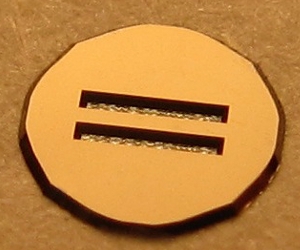Amorphous Silicon TEM Window Grid(pk10) Frame Thickness 100um, Film Thickness 5nm,2 Windows 50x1500
SPI Supplies US100-A05L
- Film Type: Continuous Amorphous Silicon
- Membrane Thickness (nm): 5 nm
- Window Size: 50 x 1500 µm
- Conductive with 1 nm ultrapure carbon coating
- Number of Windows per Grid: 2
- Frame Thickness: 100µm
- Film Type: Amorphous Silicon
- Frame Size: Fits 3mm TEM Sample Holder
- Package Size: 10 Grids
The continuous films are an amorphous silicon and may be slightly wrinkled with approximately 5 micrometers or less deflection across 100 micrometers of travel. We have found that this is typically not problem for high-resolution imaging.
The surface roughness generally ranges from 200 to 300 picometers RMS as measured by AFM. This was found to be consistent in both porous and continuous films.
100 micron frames fit a wider range of TEM sample holders, allowing more users to take advantage of our Si grids. They also allow better access to the membrane active area in high-tilt applications.
Features of Silicon membrane TEM Window Grids:
- Pure silicon composition
- 5 nm, 9 nm and 15 nm thick continuous, amorphous membranes
- 30 nm thick, nanoporous membrane
- Nanoporous: pore sizes ranging from 10 nm to 60 nm
- 100 µm thick frame
Unique Benefits of Silicon Membrane TEM Windows Grids
- Stable at high beam currents and high temperatures
- Robust enough to withstand multiples plasma cleaning, harsh deposition and chemical conditions
- Hydrophilic surface allows easy sample prep
- Reduced Chromatic Blur
Handling:
Silicon membrane window grids are amazingly robust when dry. However, care must be taken when they are wetted. We recommend avoiding excessive drying steps and using alcohols or low viscosity solvents in place of water for sample preparation. High salt solutions should also be avoided. If a salt solution is required, then a final rinse in de-ionized water is recommended to avoid depositing salt crystals on the window. Wicking of excess fluid with absorbent paper should be avoided if possible. Drying samples under light vacuum or in air is recommended. To avoid breakage, grids should be stored in the provided gel-pack and the grids should remain membrane-side facing up as packaged. We recommend handling grids using flat-sided plastic tweezers such our style K2A or K6.
Cleaning:
Silicon membrane window grids are made of pure silicon and can be repeatedly plasma cleaned without degradation. They can also be cleaned by UV-ozone without degradation. However, UV-ozone will reduce water contact angle and increase surface wetting. The silicon membrane can form a thin native oxide layer when exposed to the atmosphere. If desired, this oxide layer can be removed with a 15 second wash in 1:100 hydrofluoric acid (HF). Prolonged treatment in HF will slowly etch the silicon membrane. Warning: HF should only be used by experienced personnel with the appropriate environmental protection. Please consult the HF manufacturer's MSDS.

